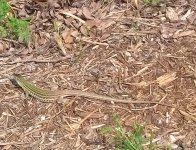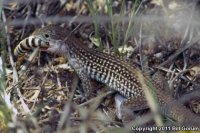| Range: |
 |
| Other Names: |
Eastern Spotted Whiptail |
| Subspecies: |
Texas Spotted Whiptail Aspidoscelis gularis gularis |
| Description: |
Slender lizard with comparatively long tail, about 3 times the head-body length. Small, granular dorsal scales with enlarged scales on back of forelimbs and along front edge of throat. Belly with 8 rows of large, rectangular scales. Dorsal ground color is brown or green-brown. Dorsal pattern consists of 7 light stripes that run from the head to the hips with the broad middorsal stripe split into two lines in some specimens; light colored spots occur on the sides between the stripes. Tail is pink to orange. Adults with sexually dimorphic coloration: males with red throat, blue belly, and black or blue coloration on chest; females with pink throat and white, unmarked belly. Maximum total length in Aspidoscelis gularis ranges from 16-28 cm (6.5-11 in). |
| Similar Species: |
The Chihuahuan Spotted Whiptail has only 6 longitudinal light stripes, spots in the space between the paravertebral stripes, only 2-8 scales between the paravertebral stripes, an unmarked ventral surface at all ages, and a greenish-gray tail. The Prairie Racerunner lacks spots on the dorsal surface and enlarged postantebrachial scales, and the anterior body color is bright green in males. |
| Venom: |
None |
| Habitat: |
Aspidoscelis gularis can be seen in a variety of habitats ranging from rocky slopes near floodplains to prairies to canyons and is almost always near a watercourse. |
| Behavior: |
This diurnal lizard actively forages for its prey in sand and debris. Aspidoscelis gularis will run if threatened, but generally it is not as wary as other whiptails. |
| Hibernation: |
Underground during the cold months |
| Reproduction: |
Breeding occurs in the spring and eggs are laid in May and June. Females lay 1-5 eggs. A second clutch may be laid in late July. Hatchlings have pink or red tails and hips. |
| Diet: |
termites, caterpillars, and large insects |













